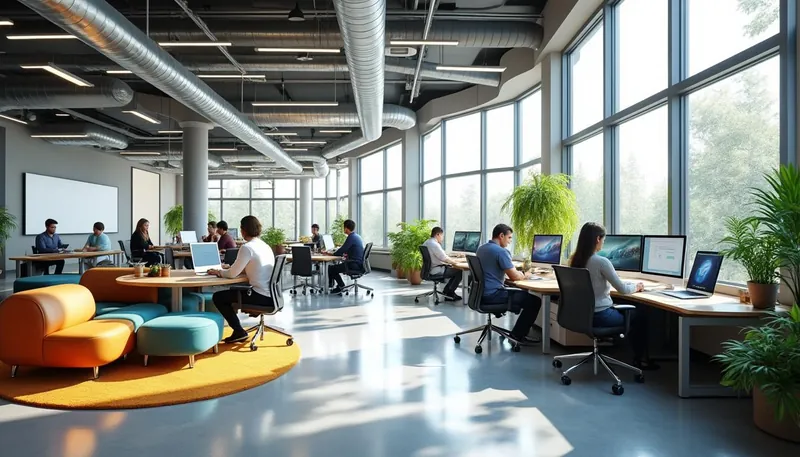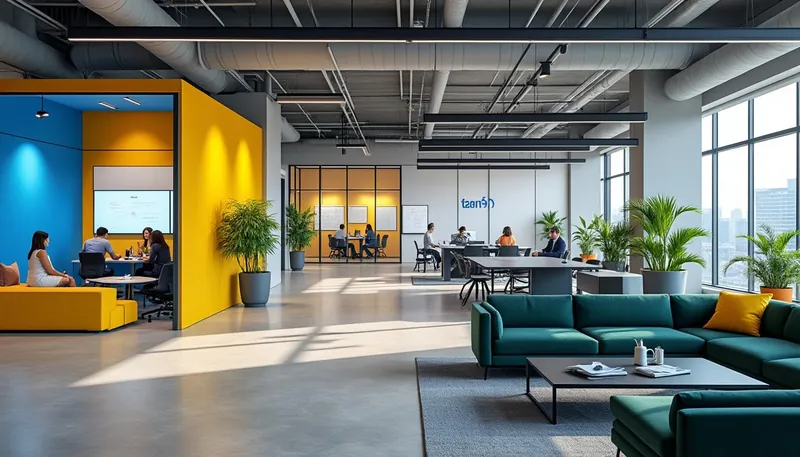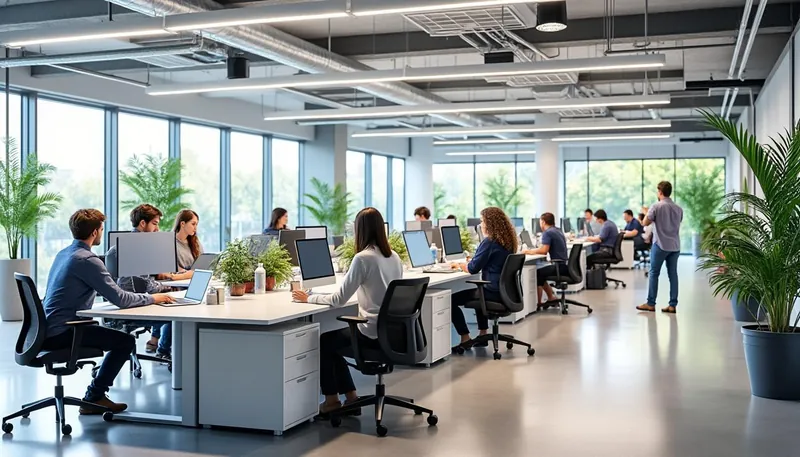In the fast-paced world of 2025, companies are beginning to recognize the critical role that an efficient office layout plays in influencing employee productivity. Traditional thinking has shifted as organizations strive to cultivate environments that not only facilitate workflow but also enhance overall employee satisfaction. A well-designed layout can create a synergy between collaboration and concentration, promoting well-being, creativity, and innovation. In this article, we delve into the various office layouts that can maximize productivity while considering the ever-evolving needs of a modern workforce.
Brief
- 🏢 Different office layout types impact productivity in unique ways.
- 🛋️ The importance of ergonomic furniture and comfort cannot be overstated.
- 🔊 Noise management techniques are essential for focused work.
- 🤝 Collaboration spaces drive team synergy and creativity.
- 💡 Energy-efficient designs can lead to significant cost savings.
Understanding Different Office Layout Types for Boosted Productivity
When considering office layouts, it’s crucial to understand that one size does not fit all. Organizations have different cultures, team dynamics, and workflows that necessitate specific workspace configurations. Let’s unpack a few common office layouts and their distinct characteristics.
1. Traditional Office Layout
The traditional office layout is characterized by individual offices or cubicles arranged in a tidy grid. This design emphasizes privacy and is optimal for tasks requiring high concentration. For instance, industries like finance and law often prefer this setup as it minimizes distractions. However, a downside is that it can deter collaboration, which is crucial for creativity.
2. Open-Plan Office
In stark contrast, the open-plan office layout creates a barrier-free environment to enhance interaction among employees. Companies like IKEA and Steelcase have pioneered this trend. While it promotes communication and team spirit, it can lead to increased noise levels. A 2025 study found that incorporating sound-absorbing materials can help mitigate this issue.
3. Team-Based Layout
With a team-based layout, workspaces are grouped into clusters for specific teams or departments. This layout fosters collaboration while still providing some degree of separation. It works exceptionally well in industries like technology, where cross-functional teamwork is prevalent. For example, a tech firm might place developers and designers close together to encourage creativity.
4. Activity-Based Working (ABW)
The ABW approach offers a versatile environment with various work settings tailored for specific tasks. Employees can select spaces suited for quiet work, group discussions, or casual meetings. Companies like Knoll have adopted ABW to support diverse work styles and encourage employee movement throughout the day.
5. Hybrid Layout
Finally, the hybrid layout is a blend of various design types. It features both open areas and private offices or quiet zones, which allows for a diverse range of work activities. For example, a hybrid office can have collaborative spaces for brainstorming sessions alongside soundproof booths for phone calls. This flexibility is becoming increasingly popular as organizations adapt to a mix of remote and in-office work.
| Office Layout Type | Benefits | Drawbacks |
|---|---|---|
| Traditional Office | 🛡️ Privacy, high concentration | 🚫 Reduced collaboration |
| Open-Plan | 🤝 Enhanced communication, lowered barriers | 🔊 Increased noise, distractions |
| Team-Based | 🎯 Improved teamwork, close collaboration | ⚖️ Potential for isolation from other teams |
| Activity-Based Working (ABW) | 🌍 Flexibility, varied work settings | 🌀 Possible confusion over space utilization |
| Hybrid | ⚙️ Versatility, best of both worlds | 💡 Complexity in design |
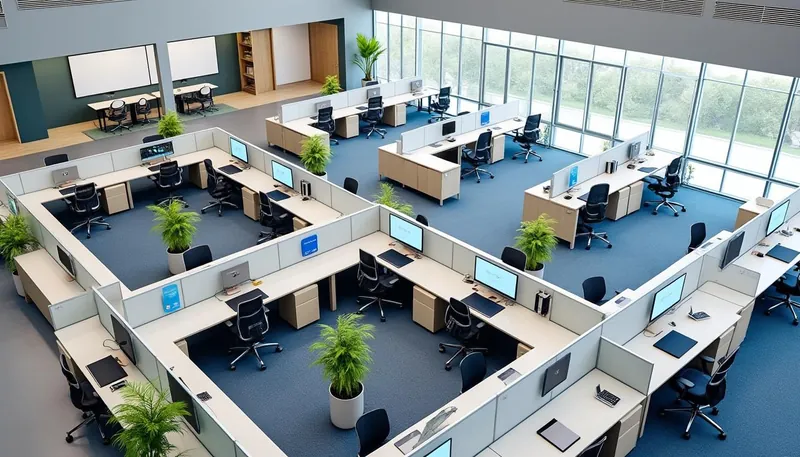
Key Considerations for Effective Office Layout Design
Designing an efficient office layout calls for mindful consideration of various factors that directly affect productivity. Here are some key aspects to keep in mind:
Workflow Analysis
Begin by examining your team’s workflow and communication patterns. This insight will inform the arrangement of workspaces and shared resources. For example, placing teams that frequently collaborate near each other can minimize downtime.
Flexibility
Today’s work environment is dynamic, necessitating layouts that can adapt to change. Organizations should consider modular furniture that can easily be rearranged. With this approach, spaces can evolve with the team’s needs, whether for project bursts or shifts in focus.
Employee Well-Being
Your layout should prioritize employee comfort. Investing in ergonomic furniture from brands like Humanscale can significantly improve morale and productivity. Remember to incorporate adjustable desks, proper lighting, and plenty of ventilation to enhance the workplace atmosphere.
Technology Integration
A modern office layout must seamlessly support technology. Ensure that power outlets, strong Wi-Fi signals, and video conferencing tools are readily available. An organized technology approach can greatly enhance efficiency, reducing the time spent searching for resources.
Privacy and Noise Management
While promoting collaboration is vital, balancing it with the need for quiet workspaces is essential. Create designated quiet zones, phone booths, or small conference rooms for focused discussions or concentrated tasks. 😌
| Design Considerations | Recommendations |
|---|---|
| Workflow and Communication | Arrange teams close that frequently collaborate 💼 |
| Flexibility | Use modular furniture for adaptable layouts 🔄 |
| Well-Being | Invest in ergonomic furniture for comfort 🛋️ |
| Technology Integration | Ensure strong Wi-Fi and video conferencing tools ⚙️ |
| Noise Management | Create quiet zones and phone booths 🤫 |
Best Practices for Implementing an Efficient Office Layout
To make the most of your office layout, adhering to best practices can facilitate smoother implementations and better outcomes:
Involve Employees in the Design Process
Engaging your team in the layout design process encourages buy-in and ensures that the workspace meets their needs. 🗣️ Gather feedback through surveys or focus groups to gain insight into their preferences and needs.
Create Diverse Work Settings
Offering a variety of spaces—collaborative zones, focus areas, and relaxation spots—can cater to different working styles and tasks. This diversity not only supports varied work activities but can also positively impact mental health.
Optimize Space Utilization
Using space planning tools can help ensure that the available office space is used efficiently. By analyzing how areas are utilized, organizations can identify underutilized spaces and repurpose them effectively.
Incorporate Biophilic Design
Integrating natural elements such as greenery, natural light, and water features can significantly enhance the workspace’s ambiance. Research indicates that biophilic design can improve mood and reduce stress, ultimately boosting productivity.
Regular Evaluation and Adjustment
Finally, it is essential to continually assess the effectiveness of the office layout. Regular feedback sessions and adjustments based on changing needs can contribute to a continually evolving work environment.
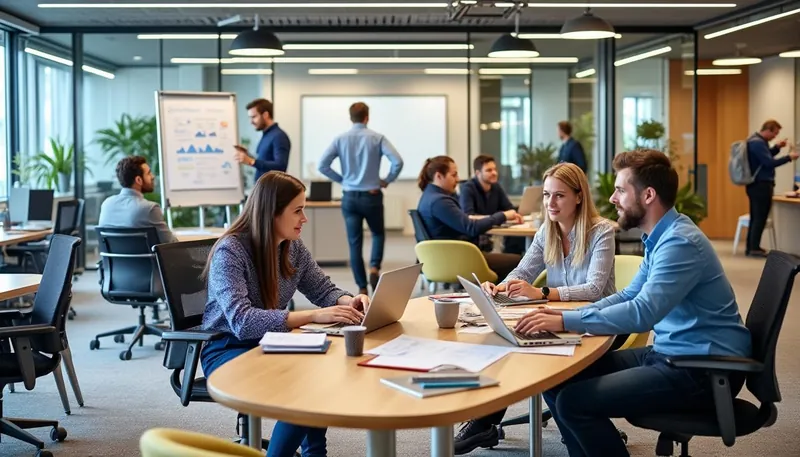
| Best Practices | Benefits |
|---|---|
| Involve Employees in Design | Increases buy-in and satisfaction 😊 |
| Diverse Work Settings | Accommodates various work styles 🛠️ |
| Optimize Space Utilization | Ensures efficient use of space 📏 |
| Biophilic Design | Enhances mood and creativity 🌱 |
| Regular Evaluation | Adapts to changing needs 🔄 |
The Impact of Office Layout on Productivity
The right office layout can yield numerous benefits for productivity and workplace satisfaction:
Enhanced Collaboration
Layouts that support spontaneous interactions—like open or team-based configurations—can foster a culture of teamwork and innovation. Employees can quickly bounce ideas off one another in an inviting atmosphere.
Improved Focus
Designated quiet zones enhance focus by providing employees with the necessary environment to complete tasks efficiently. Private spaces help employees escape distractions and zero in on complex projects.
Increased Employee Satisfaction
A thoughtful layout reflects care for employees’ needs. Comfortable, well-organized workspaces can lead to higher levels of job satisfaction and employee retention.
Better Space Utilization
Effective layouts help optimize available space, reducing real estate costs while simultaneously improving functionality. Organizations can repurpose underused areas to new needs.
Promoted Movement
Office designs that encourage movement—like flexible workstations or walking paths—can contribute to a healthier workplace. Active employees are often more engaged and productive than their sedentary counterparts.
| Impact | Details |
|---|---|
| Collaboration | 🤝 Fosters teamwork and innovation |
| Focus | 🔍 Designated quiet zones promote concentration |
| Satisfaction | 😊 Thoughtful design increases employee morale |
| Space Utilization | 📈 Optimizes real estate and reduces costs |
| Movement | 🏃♀️ Encourages a healthier work lifestyle |
What is the best office layout for productivity?
The best office layout is one that combines elements of collaboration and privacy, allowing employees to choose the most effective environment for their tasks.
How does office layout affect productivity?
A well-designed office promotes comfort, reduces distractions, fosters collaboration, and encourages creativity, all of which contribute to improved productivity.
Can an office layout help reduce energy costs?
Yes! Incorporating natural light and energy-efficient designs in your office layout can significantly lower energy bills while enhancing employee comfort.
What are some energy-saving tips for office layouts?
Maximize natural light, utilize LED lighting, and implement zoned heating/cooling systems while incorporating eco-friendly furniture.
How important is employee involvement in office design?
Engaging employees in the design process leads to layouts that meet their needs, increasing satisfaction and productivity.
